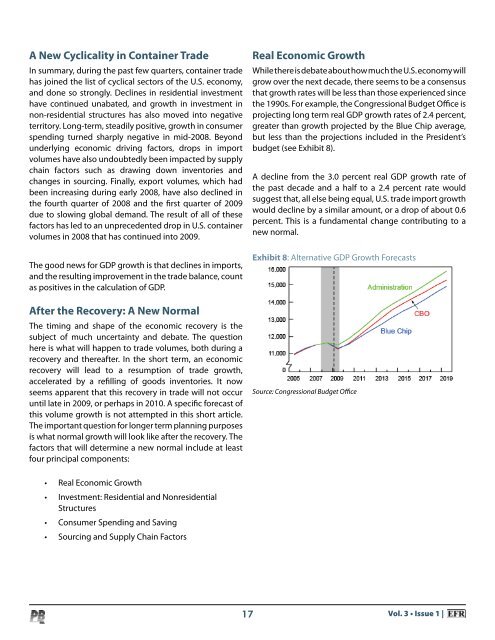Volume 3 Issue 1.indd - Parsons Brinckerhoff
Volume 3 Issue 1.indd - Parsons Brinckerhoff
Volume 3 Issue 1.indd - Parsons Brinckerhoff
Create successful ePaper yourself
Turn your PDF publications into a flip-book with our unique Google optimized e-Paper software.
A New Cyclicality in Container Trade<br />
In summary, during the past few quarters, container trade<br />
has joined the list of cyclical sectors of the U.S. economy,<br />
and done so strongly. Declines in residential investment<br />
have continued unabated, and growth in investment in<br />
non-residential structures has also moved into negative<br />
territory. Long-term, steadily positive, growth in consumer<br />
spending turned sharply negative in mid-2008. Beyond<br />
underlying economic driving factors, drops in import<br />
volumes have also undoubtedly been impacted by supply<br />
chain factors such as drawing down inventories and<br />
changes in sourcing. Finally, export volumes, which had<br />
been increasing during early 2008, have also declined in<br />
the fourth quarter of 2008 and the first quarter of 2009<br />
due to slowing global demand. The result of all of these<br />
factors has led to an unprecedented drop in U.S. container<br />
volumes in 2008 that has continued into 2009.<br />
The good news for GDP growth is that declines in imports,<br />
and the resulting improvement in the trade balance, count<br />
as positives in the calculation of GDP.<br />
After the Recovery: A New Normal<br />
The timing and shape of the economic recovery is the<br />
subject of much uncertainty and debate. The question<br />
here is what will happen to trade volumes, both during a<br />
recovery and thereafter. In the short term, an economic<br />
recovery will lead to a resumption of trade growth,<br />
accelerated by a refilling of goods inventories. It now<br />
seems apparent that this recovery in trade will not occur<br />
until late in 2009, or perhaps in 2010. A specific forecast of<br />
this volume growth is not attempted in this short article.<br />
The important question for longer term planning purposes<br />
is what normal growth will look like after the recovery. The<br />
factors that will determine a new normal include at least<br />
four principal components:<br />
Real Economic Growth<br />
While there is debate about how much the U.S. economy will<br />
grow over the next decade, there seems to be a consensus<br />
that growth rates will be less than those experienced since<br />
the 1990s. For example, the Congressional Budget Office is<br />
projecting long term real GDP growth rates of 2.4 percent,<br />
greater than growth projected by the Blue Chip average,<br />
but less than the projections included in the President’s<br />
budget (see Exhibit 8).<br />
A decline from the 3.0 percent real GDP growth rate of<br />
the past decade and a half to a 2.4 percent rate would<br />
suggest that, all else being equal, U.S. trade import growth<br />
would decline by a similar amount, or a drop of about 0.6<br />
percent. This is a fundamental change contributing to a<br />
new normal.<br />
Exhibit 8: Alternative GDP Growth Forecasts<br />
Source: Congressional Budget Office<br />
• Real Economic Growth<br />
• Investment: Residential and Nonresidential<br />
Structures<br />
• Consumer Spending and Saving<br />
• Sourcing and Supply Chain Factors<br />
17 Vol. 3 • <strong>Issue</strong> 1 |

















